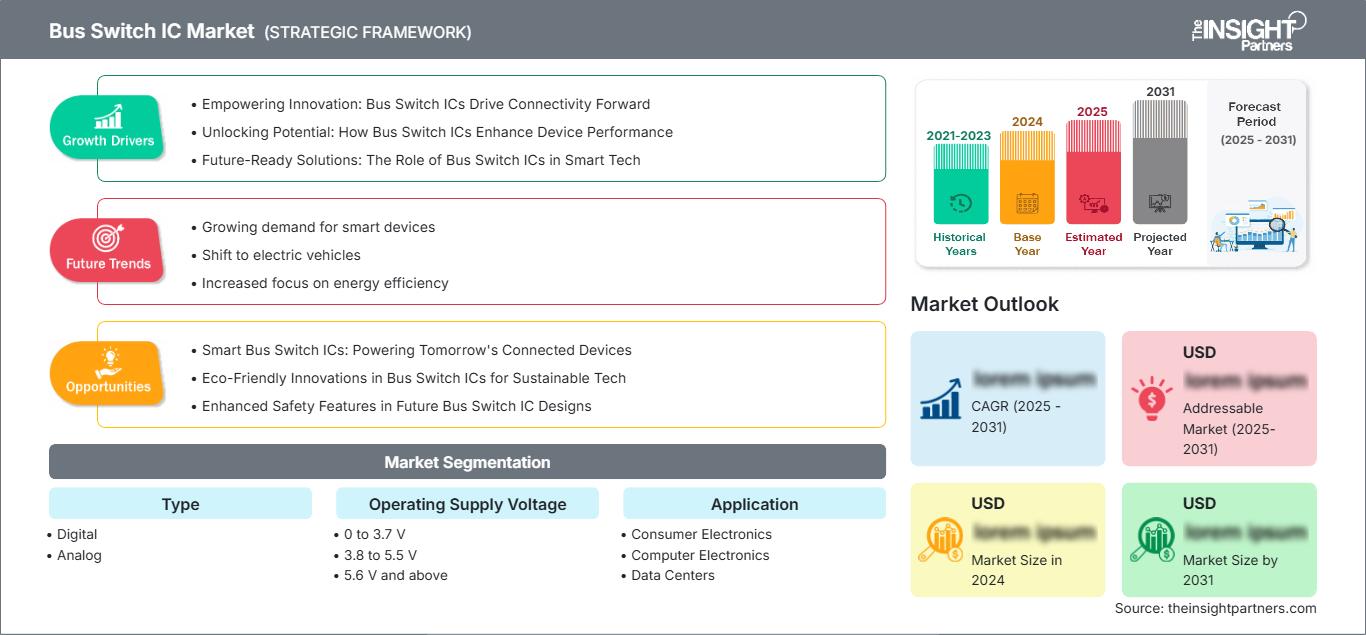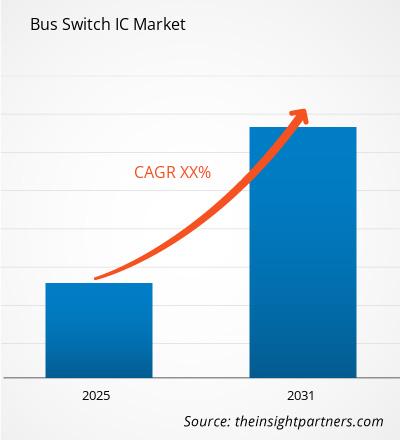Se prevé que el mercado de circuitos integrados de conmutación para autobuses registre un crecimiento constante de 2026 a 2034, con una valoración que crecerá desde la línea base de 2025 y avance hacia una expansión sostenida hasta el final del periodo de previsión. Esta tendencia refleja una perspectiva favorable del mercado impulsada por la evolución de los requisitos de la industria y los continuos avances tecnológicos.
El informe está categorizado por tipo (Digital, Analógico) y analiza el mercado en función del voltaje de suministro de funcionamiento (0 a 3,7 V, 3,8 a 5,5 V, 5,6 V y superiores). También examina el mercado por aplicación (Electrónica de Consumo, Electrónica Informática, Centros de Datos). Se ofrece un desglose exhaustivo a nivel global, regional y por país para cada uno de estos segmentos clave.
El informe incluye el tamaño del mercado y las previsiones en todos los segmentos, presentando valores en USD. También ofrece estadísticas clave sobre el estado actual del mercado de los principales actores, junto con información sobre las tendencias predominantes y las oportunidades emergentes.
Propósito del informe
El informe Mercado de circuitos integrados con interruptores de bus de The Insight Partners pretende describir el panorama actual y el crecimiento futuro, los principales factores impulsores, los retos y las oportunidades. Esto proporcionará información a diversos actores empresariales, como:
- Proveedores de tecnología/fabricantes: Para comprender la dinámica cambiante del mercado y conocer las posibles oportunidades de crecimiento, permitiéndoles tomar decisiones estratégicas informadas.
- Inversores: Realizar un análisis exhaustivo de tendencias sobre la tasa de crecimiento del mercado, las proyecciones financieras y las oportunidades que existen a lo largo de la cadena de valor.
- Organismos reguladores: Regular las políticas y vigilar las actividades en el mercado con el objetivo de minimizar el abuso, preservar la confianza y la confianza de los inversores, y mantener la integridad y estabilidad del mercado.
Segmentación de mercado de circuitos integrados con conmutadores de bus
- Analógico
- digital
Tensión de alimentación
- de funcionamiento 0 a 3,7 V
- 3,8 a 5,5 V
- 5,6 V o más
- Aplicación Electrónica
- de Consumo Electrónica Informática
- Centros
Disfrutará de la personalización gratuita de cualquier informe, incluyendo partes del mismo, análisis por país y un paquete de datos de Excel. Además, podrá aprovechar excelentes ofertas y descuentos para startups y universidades.
Mercado de circuitos integrados de conmutación de bus: Perspectivas estratégicas

-
Obtenga las principales tendencias clave del mercado de este informe.Esta muestra GRATUITA incluye análisis de datos, desde tendencias del mercado hasta estimaciones y pronósticos.
Impulsores del crecimiento del mercado de circuitos integrados de conmutación de bus
- Impulsando la innovación: los circuitos integrados de conmutación de bus impulsan la conectividad
- Desbloqueando el potencial: cómo los circuitos integrados de conmutación de bus mejoran el rendimiento del dispositivo
- Soluciones preparadas para el futuro: el papel de los circuitos integrados de conmutación de bus en la tecnología inteligente
Tendencias futuras del mercado de circuitos integrados de conmutación de bus
- Creciente demanda de dispositivos inteligentes
- Transición a vehículos eléctricos
- Mayor enfoque en la eficiencia energética
Oportunidades del mercado de circuitos integrados de conmutación de bus
- Circuitos integrados de conmutación de bus inteligentes: impulsando los dispositivos conectados del futuro
- Innovaciones ecológicas en circuitos integrados de conmutación de bus para una tecnología sostenible
- Características de seguridad mejoradas en los futuros diseños de circuitos integrados de conmutación de bus
Mercado de circuitos integrados de conmutación de bus
Los analistas de The Insight Partners han explicado detalladamente las tendencias regionales y los factores que influyen en el mercado de circuitos integrados (CI) de conmutadores de bus durante el período de pronóstico. Esta sección también analiza los segmentos del mercado de gestión de enfermedades del ritmo cardíaco y la geografía en América del Norte, Europa, Asia Pacífico, Oriente Medio y África, y América del Sur y Central.
Alcance del informe de mercado de circuitos integrados de conmutación de bus
| Atributo del informe | Detalles |
|---|---|
| Tamaño del mercado en 2025 | US$ XX Million |
| Tamaño del mercado por 2034 | US$ XX Million |
| CAGR global (2026 - 2034) | XX% |
| Datos históricos | 2021-2024 |
| Período de pronóstico | 2026-2034 |
| Segmentos cubiertos |
By Tipo
|
| Regiones y países cubiertos |
Norteamérica
|
| Líderes del mercado y perfiles de empresas clave |
|
Densidad de participantes en el mercado de circuitos integrados de conmutación de bus: comprensión de su impacto en la dinámica empresarial
El mercado de circuitos integrados (CI) de conmutadores de bus está creciendo rápidamente, impulsado por la creciente demanda de los usuarios finales debido a factores como la evolución de las preferencias de los consumidores, los avances tecnológicos y un mayor conocimiento de las ventajas del producto. A medida que aumenta la demanda, las empresas amplían su oferta, innovan para satisfacer las necesidades de los consumidores y aprovechan las tendencias emergentes, lo que impulsa aún más el crecimiento del mercado.

- Conseguir el Mercado de circuitos integrados de conmutación de bus Resumen de las principales jugadoras clave
Puntos Clave de Venta
- Cobertura Integral: El informe abarca el análisis exhaustivo de productos, servicios, tipos y usuarios finales del mercado de CI de Conmutación de Bus, ofreciendo un panorama holístico.
- Análisis de Expertos: El informe se elabora con base en el profundo conocimiento de expertos y analistas de la industria.
- Información Actualizada: El informe garantiza relevancia para el negocio gracias a su cobertura de información y tendencias de datos recientes.
- Opciones de Personalización: Este informe se puede personalizar para satisfacer las necesidades específicas del cliente y adaptarse a las estrategias comerciales.
Por lo tanto, el informe de investigación sobre el mercado de CI de Conmutación de Bus puede ayudar a liderar el camino para decodificar y comprender el escenario de la industria y las perspectivas de crecimiento. Si bien puede haber algunas preocupaciones válidas, las ventajas generales de este informe tienden a superar las desventajas.
- Análisis histórico (2 años), año base, pronóstico (7 años) con CAGR
- Análisis PEST y FODA
- Tamaño del mercado, valor/volumen: global, regional y nacional
- Industria y panorama competitivo
- Conjunto de datos de Excel
Informes recientes
Informes relacionados
Testimonios
Razón para comprar
- Toma de decisiones informada
- Comprensión de la dinámica del mercado
- Análisis competitivo
- Información sobre clientes
- Pronósticos del mercado
- Mitigación de riesgos
- Planificación estratégica
- Justificación de la inversión
- Identificación de mercados emergentes
- Mejora de las estrategias de marketing
- Impulso de la eficiencia operativa
- Alineación con las tendencias regulatorias






















 Obtenga una muestra gratuita para - Mercado de circuitos integrados de conmutación de bus
Obtenga una muestra gratuita para - Mercado de circuitos integrados de conmutación de bus